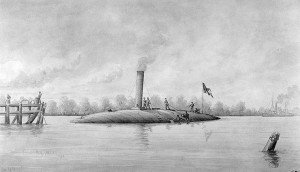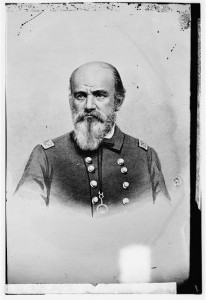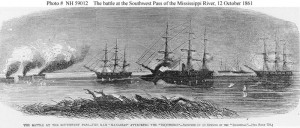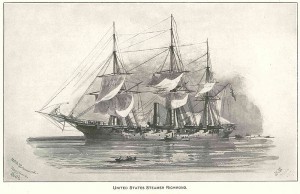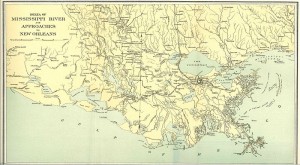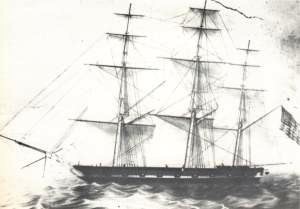I got in over my head yesterday as I was exploring the October 12, 1861 naval battle at the Head of Passes. The articles that The New-York Times reproduced from Southern papers had some major factual errors.
Sometime on the night of October 11-12, 1861 the Battle of the Head of Passes commenced. A small Confederate Mosquito Fleet stationed on the Mississippi River near New Orleans and under the command of George N. Hollinsattacked the Union blockading fleet at the mouth of the Mississippi – the Head of Passes. Leading the Rebel attack was the commandeered CSS Manassas, an icebreaker converted into a “turtle-shaped” ironclad ram. The Manassas was able to ram and somewhat damage the USS Richmond but sustained enough damage itself that it was ineffective for the rest of the battle (but Union shells bounced off its armor). By sunrise all the U.S. vessels save one had run aground as they fled downriver to avoid the remaining Confederate ships. By 10 AM Hollins determined that the Confederate ships were too low on coal and ammunition to continue shelling the stationary Union ships and headed back up the river. Here’s a couple accounts in The New-York Times via Southern newspapers. Hollins and/or the newspapers exaggerated or mislead the public. The USS Preble was not sunk and was the only Union ship not run aground. The battle appears to be a victory for Southern morale but did not impair the Union blockade much at all.
From The New-York Times October 16, 1861:
IMPORTANT FROM NEW-ORLEANS.; REPORTED ATTACK ON THE NATIONAL FLEET.
BALTIMORE, Tuesday, Oct. 15.
The Norfolk Examiner of Monday, which has been received by a flag of truce, contains a dispatch dated New-Orleans. Oct. 12, stating that a naval engagement had taken place at the head of the Passes, on the night of the 11th, lasting one hour, and was afterwards renewed.
Also the following dispatch:
FORT JACKSON, Saturday, Oct. 12.
Last night I attacked the blockaders with my little fleet. I succeeded, after a very short struggle, in driving them all aground on the Southwest Pass bar except the Preble, which I sunk.
I captured a prize from them, and after they were fast in sand I peppered them well.
There were no casualties on our side. It was a complete success. HOLLINS.
NEW-ORLEANS, Sunday, Oct. 13.
The force of the National fleet was 40 guns and nearly 1,000 men, while the little Confederate mosquito fleet was 16 guns and 300 men.
It is reported that our iron steamer sunk the Preble, with her iron plow.
Commander HOLLINS arrived last night.
BALTIMORE, Tuesday, Oct. 15 — P.M.
Another dispatch, dated from New-Orleans, expresses the belief that a sufficient force can be organized to capture the whole National fleet, in its present disabled condition.
The rebel fleet was in the command of Commodore HOLLINS.
From The New-York Times October 18, 1861:
IMPORTANT FROM THE SOUTH.; Further Particulars of the Reported Naval Engagement at New-Orleans. HOW THE PREBLE WAS SUNK. New-Orleans Illuminated for a Victory. …
…
The Petersburgh Express has the following additional particulars concerning the late reported naval engagement at New-Orleans:
The Turtle ran against the Preble without firing a gun, and immediately sunk her, by staving in her sides, she, in the meantime being fired upon by the whole squadron, but the balls glancing from her iron form without effecting the least damage.
The Turtle then turned on the other two vessels, which, seeing the fate of their companion, endeavored to get out of the way, in which effort they were driven on shore, their crews deserting them. Com. HOLLINS, in his report, says he thinks he will be able to capture and carry them both into New-Orleans.
The Preble cannot be raised. A large number of prisoners, arms, ammunition, &c., were taken during the action. Com. HOLLINS confirms the account of the defeat of BILLY WILSON’s Zouaves on Santa Rosa Island.
Com. HOLLINS arrived in New-Orleans on the 14th ult. The city was illuminated on the receipt of the intelligence.
The number of men under Com. HOLLINS was 300. The Federalists numbered 1,000.
The same journal has the following comments on the affair:
“The Confederate cause has again been victorious. Capt. HOLLINS, of our little navy, has succeeded in driving the blockading squadron of the —– Yankees at the mouth of the Mississippi, ashore, capturing a prize, and sinking the crack sloop-of-war Preble. Such particulars as have reached us will be found in our telegraphic dispatches. They are, as yet, quite meagre-just enough to create a desire for more, and enkindle a most lively feeling of satisfaction. With a large force, we should think the stranded vessels might easily be captured. At all events, they will not soon forget the thorough peppering Capt. HOLLINS informs us he has administered. We regret that our knowledge of Capt. GEORGE N. HOLLINS, the hero of this fight, is too limited to enable us to give such a sketch of his life, as we know would prove highly interesting at this time. But the Naval Register of 1859 informs us that he is a native of Maryland, and was appointed from Maryland, but was at the time of his appointment a citizen of Florida. We may add that HOLLINS entered the service of the United States Navy on the 1st of February, 1814, and his commission of Captain was dated on the 14th September, 1855. As soon as the present troubles commenced, he resigned his position in the navy, after drawing considerable pay, and was immediately appointed with a post of equal rank in the Confederate States Navy. It is well known that HOLLINS had much to do with the capture of the side-wheel steamer St. Nicholas, Capt. KIRWAN, of the Baltimore and Washington line, which was taken a few months since, near the mouth of the Potomac River, by Col. ZARVOONA THOMAS. …

